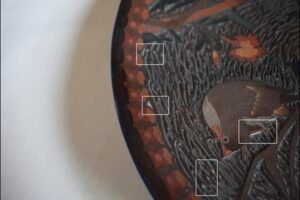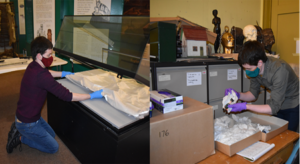Museums and Galleries Practice course at the Stirling Smith
Introduction
Hello, my name is Alan Gardiner and I’m currently employed as a Museum Assistant at the Smith Art Gallery and Museum in Stirling, home to the collection of artworks produced and collected by the museum’s founder Thomas Stuart Smith. Prior to the pandemic, I was employed as the assistant to the museum’s Collections Manager.
My experience
I was happy to accept the opportunity to be enrolled to the Museums and Galleries Practice course by the Director, after my contract as the Collections Assistant ended in March 2021. This allowed me to continue my involvement with the museum’s collection, learn new skills, connect with other individuals working in the cultural heritage sector and continue my development.
Following my course induction and meeting the assessor, I began by completing the Understand the sector in which you work unit, which was about the Scottish cultural heritage sector. This unit gave me a better understanding of how the sector operates, how funding is acquired and identify the most influential organisations. I was then asked to research the Career Personal Development unit, to consider how this could benefit my career progression and to produce a career development plan. This unit was an excellent opportunity to consider the next step in my career and to reflect on my achievements, experience, and skills that I had already acquired.
The criteria of the next unit asked me to consider my role as a Museum Assistant and how I help to enhance the experience of museum visitors. Fulfilling the criteria of this unit was enjoyable, as it allowed me to interact more with visitors and introduce an innovation that would enhance the visitor experience. Also, it was during this unit that I finally got to meet my course assessor in person, who came to the museum to gather evidence to fulfil some of the criteria for this unit, by observing me whilst I was working and asking me questions.
For the remaining five units, we merged them into a large project which was to create a small exhibit. I wanted to work with the Smith’s collection of Japanese objects. I began this project by fulfilling the criteria for the Inspect and monitor conservation needs of cultural heritage unit, which involved an analysis of the objects and identifying the different materials used to create each item. I discussed the problems associated with the care of the items, how items should be stored and exhibited safely, and consider the measures that can be taken to prevent deterioration. I assessed each item for signs of damage that may prevent an object from being displayed and demonstrated my knowledge of the possible causes of any condition changes to my assessor.
Porcelain and lacquer plate from the Owari province. This photograph was produced to show the conservation issues and damage that Alan recorded when carrying out a condition assessment. The areas highlighted show formations of mould and dust.

After completing these tasks, I prepared for the small exhibition. I considered the methods that I could use to provide information about this collection, to both museum visitors and staff, and review my research notes for each object, in order to identify relevant information that I could add to the museum’s collections database. In terms of providing information to visitors and staff, I created a visitor information booklet to accompany my display. It contained information about the objects, a history of the Smith’s Japanese collection and short history of Japanese design and manufacturing techniques. I collated my object assessment notes into reports, which I sent on to the museum’s Collections Manager, as evidence of providing information to my museum colleagues.
The final unit involved exhibiting the Japanese objects that I had been working with. This process began with a review of the object condition reports led by the Collections Manager, to ensure that the items were in a stable condition and could go on display. This was followed by deciding on a suitable layout for the objects and carrying out an assessment of the display case. Finally, I was given permission to install my exhibit, which I performed with the assistance of the museum’s Collections Manager.
Left: Alan preparing the display case that he’d be using to display the Japanese objects. Right: Alan safely packing the Japanese objects

Overall, I thoroughly enjoyed undertaking the Museums and Galleries Practice course. For me, this course acted as a good “refresher”, as the pandemic halted all my work within a museum environment and all the practical tasks involved with managing a museum collection provided me with an excellent opportunity to expand my knowledge before returning to the workplace.
This course gave me a chance to reflect on my development both personally and professionally, and consider my future career aims, as well as enabling me to connect with other individuals working in the cultural heritage sector. Furthermore, I found this course very rewarding, and I would highly recommend it to anyone wishing to begin a career within the cultural heritage sector and would particularly appeal to people looking to work within a museum environment or with a collection of items.